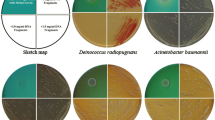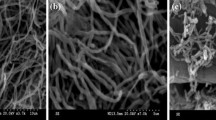Abstract
Chloramphenicol resistance is an unstable character inStreptomyces fradiae, since spontaneous chloramphenicol-sensitive (Cmls) mutants arose at very high frequencies. One such Cmls mutant, DM14, showed DNA amplification as well. Extracellular protease activity was tenfold higher in DM14 when compared with its wild-type parent. Protease activity decreased considerably in DM14 when treated with spectinomycin, a treatment that reduces the copy number of amplified units of DNA. Sporulation in DM14 was delayed in the presence of spectinomycin at a concentration of 5 μg/ml, whereas the wild type was unaffected at that concentration. The results strongly indicated that the amplified DNA affected the two secondary metabolic functions, viz., protease production and the onset of sporulation in the mutant.
Similar content being viewed by others
Literature Cited
Altenbuchner J, Cullum J (1984) DNA amplification and unstable arginine gene inStreptomyces lividans 66. Mol Gen Genet 195:134–138
Altenbuchner J, Cullum J (1985) Structure of an amplifiable DNA sequence inStreptomyces lividans 66. Mol Gen Genet 201:192–197
Baltz RH, Stonesifer J (1985) Phenotypic changes associated with loss of expression of tylosin biosynthesis and resistance genes inStreptomyces fradiae. J Antibiot 38:1226–1236
Chatterjee S, Vining LC (1982) Catabolite repression inStreptomyces venezuelae. Induction of β-galactosidase, chloramphenicol production and intracellular cyclic adenosine 3′-5′ monophosphate concentrations. Can J Microbiol 28:311–317
Fishman SE, Hershberger CL (1983) Amplified DNA inStreptomyces fradiae. J Bacteriol 155:459–466
Fishman SE, Rosteck PR Jr, Hershberger CL (1985) A 2.2-kilobase repeated DNA segment is associated with DNA amplification inStreptomyces fradiae. J Bacteriol 161:191–206
Flett F, Platt J, Cullum J (1987) DNA rearrangements associated with instability of an arginine gene inStreptomyces coelicolor A3(2). J Basic Microbiol 27:3–10
Freeman RF, Hopwood DA (1978) Unstable naturally occurring resistance to antibiotics in Streptomyces. J Gen Microbiol 106:377–381
Freeman RF, Bibb MJ, Hopwood DA (1977) Chloramphenicol acyltransferase-independent chloramphenicol resistance inStreptomyces coelicolor A3 (2). J Gen Microbiol 98:453–465
Gibb GD, Strohl WR (1988) Physiological regulation of protease activity inStreptomyces peucetius. Can J Microbiol 34:187–190
Ginther CL (1979) Sporulation and the production of serine protease and cephamycin C byStreptomyces lactamdurans. Antimicrob Agents Chemother 15:522–526
Hasegawa M, Hintermann G, Simonet JM, Crameri R, Piret J, Hutter R (1985) Certain chromosomal regions inStreptomyces glaucescens tend to carry amplifications and deletions. Mol Gen Genet 200:375–384
Hausler A, Birch A, Krek W, Piret J, Hutter R (1989) Heterogeneous genomic amplification inStreptomyces glaucescens: structure, location and junction sequence analysis. Mol Gen Genet 217:437–446
Hintermann G, Crameri R, Vogtli M, Hütter R (1984) Streptomycin-sensitivity inStreptomyces glaucescens is due to deletions comprising the structural gene coding for a specific phosphotransferase. Mol Gen Genet 196:513–520
Hodgson DA (1982) Glucose repression of carbon source uptake and metabolism inStreptomyces coelicolor A3 (2) and its perturbation in mutants resistant to 2-deoxyglucose. J Gen Microbiol 128:2417–2430
Hopwood DA, Bibb MJ, Chater KF, Kieser T, Bruton CJ, Kieser HM, Lydiate DJ, Smith CP, Ward JM, Schrempf H (1985) Genetic manipulation of Streptomyces—a laboratory manual. Norwich: The John Innes Foundation
Horinouchi S, Kumada Y, Beppu T (1984) Unstable genetic determinant of A-factor biosynthesis in Streptomycin-producting organisms: cloning and characterization. J Bacteriol 158: 481–487
Hütter R, Eckhardt T (1988) Genetic manipulation. In: Goodfellow M, Williams ST, Mordarski M (eds) Actinomycetes in biotechnology. San Diego: Academic Press, pp 89–184
Kirby R, Lewis E (1981) Unstable genetic elements affecting streptomycin resistance in the streptomycin-producing organismsStreptomyces griseus NCIB 8506 andStreptomyces bikiniensis ISP 5235. J Gen Microbiol 122:351–355
Long EO, Dawid IB (1980) Repeated genes in eukaryotes. Annu Rev Biochem 49:727–764
Lowry OH, Rosebrough NJ, Farr AL, Randall RJ (1951) Protein measurement with the Folin phenol reagent. J Biol Chem 193:265–275
Mathumathi R, Kumaravel S, Dharmalingam K (1990) Deamplification and deletion of amplified DNA inStreptomyces lividans andStreptomyces fradiae. Appl Microbiol Biotechnol 33:291–295
Murakami T, Holt TG, Thompson CJ (1989) Thiostrepton-induced gene expression inStreptomyces lividans. J Bacteriol 171:1459–1466
Ono H, Hintermann G, Crameri R, Wallis G, Hutter R (1982) Reiterated DNA sequences in a mutant strain ofStreptomyces glaucescens and cloning of the sequence inEscherichia coli. Mol Gen Genet 186:106–110
Polsinelli M, Beretta M (1966) Genetic recombination in crosses betweenStreptomyces aureofaciens andStreptomyces rimosus. J Bacteriol 91:63–68
Redshaw PA, Mc Cann PA, Pentella MA, Pogell BM (1979) Simultaneous loss of multiple differentiated functions in aerial mycelium-negative isolates of Streptomyces. J Bacteriol 137: 891–899
Sambrook J, Fritsch EF, Maniatis T (1989) Molecular cloning: a laboratory manual. Cold Spring Harbor Laboratory, New York: Cold Spring Harbor Laboratory Press
Schrempf H (1983) Deletion and amplification of DNA sequences in melanin-negative variants ofStreptomyces reticuli. Mol Gen Genet 189:501–505
Singh DV, Sukumaran CP, Sharma MC, Singh VP, Singh P, Gupta KK (1982) Role for proteases and alkaline phosphatase in streptomycin biosynthesis. Indian J Biochem Biophys 19:145–147
Usdin K, Christians KM, Dewet CA, Potgieter TD, Shaw CB, Kirby R (1985) The loss of a large DNA fragment is associated with an aerial mycelium negative (Amy−) phenotype ofStreptomyces cattleya. J Gen Microbiol 131:979–981
Author information
Authors and Affiliations
Rights and permissions
About this article
Cite this article
Ratnakumari, T.S., Mathumathi, R. & Dharmalingam, K. DNA amplification affects protease production and sporulation inStreptomyces fradiae . Current Microbiology 29, 101–107 (1994). https://doi.org/10.1007/BF01575756
Issue Date:
DOI: https://doi.org/10.1007/BF01575756




